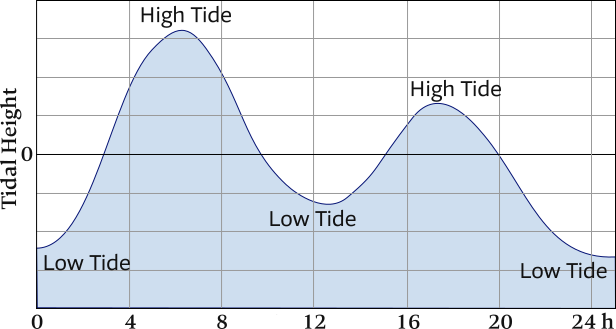

The Moon's gravitational attraction for the water on the near side of the ball is stronger than its attraction for the water on the far side of the ball. The simplest way to think about the question of a tide on the side of the Earth opposite the Moon is to imagine the Earth being replaced by a huge ball of water. The Earth is so much more massive than the Moon that the barycenter is actually about 1000 miles below the surface of the Earth directly below the Moon. The bigger parent has to be closer to the balance point (barycenter) to make the seesaw operate properly. It's a bit like playing on a seesaw with a little child.

Since the Earth is much larger than the Moon, the barycenter is much closer to the Earth's center than to the Moon's center. Actually the Earth and Moon both rotate around their common center of gravity called the “barycenter”. Most of us have been taught that the Moon revolves around the Earth. One of the most common questions asked about tides is why there is a high tide on the side of the Earth facing away from the moon. When it comes to tides, distance trumps mass. The Sun and the Moon are the only bodies in space that have a significant effect on the tides, and because the Moon is so much closer to the Earth, it has roughly twice the tide producing force of the Sun. The tractive force that creates tides is also a function of the mass of the bodies involved, but the cube of the distance between them. The strength of the gravitational attraction between two bodies depends on their masses and the square of the distance between them. Any two bodies in space exert an attractive force on one another. We will only touch on the most important of these. The bad news is that there are a lot of complicating factors that influence the actual height of the tides. In the case of the ocean tides it is almost exclusively the gravity between the Earth and the Moon, and the gravity between the Earth and the Sun. What makes the water rise and fall with respect to the land? The good news is that there is only one thing that causes tides, and that is gravity. But why do we have all these various patterns that we find in the tide book? Why do we have mixed tides? Why are tides later each day? Why is there a difference between summer and winter? The answers are pretty complex!įirst let’s look at what causes tides.
#NETARTS TIDE GRAPH FULL#
Most people know that the tides have something to do with the moon, its gravitaional pull and its phase, and that the greatest tidal ranges are associated with full and new moons. Other parts of the world may have diurnal tides, one high and one low a day, or semidiurnal tides with two highs and two lows of equal size.
#NETARTS TIDE GRAPH SERIES#
We may also notice that there is a series of low tides about every two weeks or so, usually the lower of the two lows in the morning (AM) during the summer and in the evening (PM), usually after dark, during the winter. If we look at the times of the tides on successive days, such as the AM high tides in December, we find that they occur later from one day to the next. and P.M., and that there is a higher high and a lower high and a higher low and a lower low, a phenomenon called “mixed tides.” The favored minus tides (those below the mean of lower low water which is designated as the “zero level”) are highlighted in red. We can see from the these pages that there are usually two high tides and two low tides each day, A.M. Reproduced here are tide tables for June 2005 and December 2005.

Where do all these times and values come from and what do they really mean? We will try to provide some answers. Most of us take these tables on faith with only a little understanding of the processes behind them. Here we find the dates, times, and levels of tides. and distributed to local stores and other outlets. Low tides leave isolated tide pools that let us discover the biological zones that cover the vertical faces of rocks, where starfish prey on mussels living just above them, and green anemones show their faces to young children who gently poke fingers into their mouths and feel the tingle of tentacles that close around them.īefore heading to the shore, we often examine tide tables corrected for Tillamook County beaches, published locally by Coast Printing & Stationary, Inc. A favorite time for both locals and visitors to explore the seashore is at low tide when the ocean recedes to reveal the myriad of animals and seaweeds that inhabit the sand and rocks, life that is otherwise hidden from view.


 0 kommentar(er)
0 kommentar(er)
